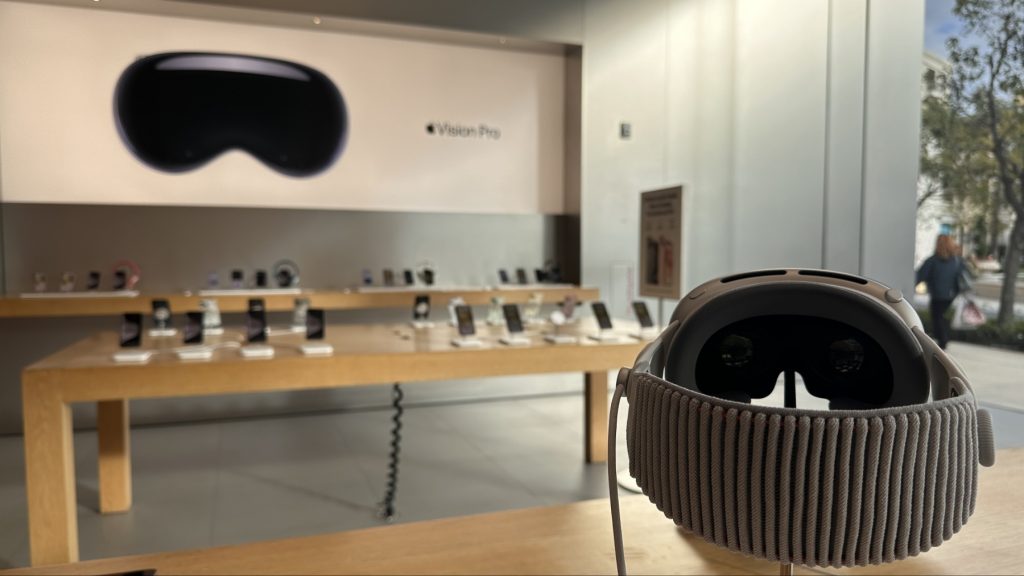
Some team members within Apple’s vision products group, believe that the Apple Vision Pro could take four generations before it reaches its “ideal form” of browsing experience, according to Bloomberg.
The headset serves as an alternative device to the iPad, offering a unique browsing experience, displaying images and videos, as well as watching content, along with easy navigation, posing a threat to the future of Apple tablets.
Mark Gurman, Bloomberg’s tech editor, pointed out that the iPad was initially supposed to be the lightweight, portable computing device that would allow users to interact with content, view images and videos, and check emails on the move, without the need for a MacBook. Additionally, its screen would be larger than the iPhone’s.
However, over time, the future of the iPad has become uncertain, as it is still unable to deliver the strong performance of Apple’s personal computers. Gurman expects Apple’s launch of its Vision Pro to be “a new attempt to create a practical alternative to Mac computers,” especially since the smart headset offers an interactive and rich experience with a comfortable user interface in conditions such as being on a plane or sitting comfortably on a couch, without the need for a physical keyboard or mouse.
Despite the future potential of the Vision Pro, Gurman believes “it’s going to take some hardware upgrades, a slew of software updates, and far better support from app developers and content makers to actually make the headset the iPad replacement that it’s capable of being.”
Additionally, the editor says that on the level of the physical components, the company should completely stop the selling of the Solo Band Strap since it exhausts the user’s neck and head when wearing the headset and makes the potential for use no more than half an hour, while the Dual Band offers a comfortable experience for hours of use.
He also noted that the quality of the external Passthrough Cameras, responsible for the ability to see the real world around the user while wearing the Apple Vision Pro, needs a mix of development, as they are often inaccurate. Gurman described their quality as no different from what the external sensors for Meta’s Quest 3 headset offers, which are priced at $500, compared to the $3500 price of Apple’s headset.
In parallel, at the level of internal headset screens, for which Apple says, it allows 4K display quality for each eye, it suffers from some flaws in display accuracy, such as blurry details as well as the feeling that the content appears in front of the eyes as if looking through magnifying glasses, there are black parts at the edges, the content does not fill the space before the eyes, making the viewing experience uncomfortable.
While Gurman acclaimed the accuracy of the hand and eye tracking system, he criticized its lack of smooth and fast operation throughout the user experience. This may require the user to restart the headset completely, and sometimes even perform a complete setup process for it.
For the battery, Gurman sees that the wire connecting the external battery to the headset needs to be available in different lengths in order for it to fit with various use conditions, as well as for the battery size. This allows to increase the battery’s capacity and to extend its duration usage for more than two hours only.
The editor also highlighted some issues related to the interface of the apps of the Vision Pro. He emphasized that all iPad apps developed to work on Apple’s headset lack precision in responsiveness, with user control of their interfaces through hand and eye movements.
Gurman described his experience with the headset’ apps as “annoying” at times because many elements of the user interface do not work properly. With eye movement, incorrect elements may be pressed. He cited the difficulty of closing app windows by focusing on the small button at the bottom of each window.
Multiple examples mentioned by the technical editor about the difficulty of his experience with the new Vision Pro glasses, such as the disruption of the Apple Music app once it is on, the difficulty of logging into the Zoom app to make calls, as well as the non-appearance of the dedicated button for streaming content from the MacBook screen to the inside of the headset.
He also noted that it is difficult to use physical keyboards via Bluetooth with Apple’s product, when working within its virtual Environments, as the user does not see the keyboard and therefore finds it difficult to type.
Additionally, Gurman criticized the lack of content available on the Apple Vision Pro, such as the Mail and Calendar apps, which do not have developed versions for the headset, especially as the company has worked 8 years to develop them.
Therefore, Gurman believes that the Apple Vision Pro headset still needs major improvements. While the first version of it is just a pilot model, users need to pay $3,500 to go through the experience. At the same time, he believes it will achieve great success if Apple were to develop deficiencies in physical components, operating system and content.
Inside Telecom provides you with an extensive list of content covering all aspects of the tech industry. Keep an eye on our Tech sections to stay informed and up-to-date with our daily articles.